It seems that August was mostly about the insects in my gardens, though a sprinkling of birds and spiders and lizards added a bit of spice to things. Welcome to Wildlife Wednesday, marked each month on the first Wednesday in observance and celebration of the wonderful wild creatures that we share our world with and who are necessary for gardens to be.
My good camera has spent this past month at the camera hospital, with a full recovery predicted. No matter, I took decent photos of most things–plants and critters, with a reliable, but limited, point-n-shoot camera.
I’m flustered when birds don’t perch still and pose nicely for me. With the good camera, shots are crisp and clear, birds flitting and flying notwithstanding. With the point-n-shoot, bird photos are never quite what I see in real life. Nevertheless, there are lots of birds in the late summer garden and a few presentable photos in which to profile them. The birds of August in Austin are the the usual suspects–Grackles, European House Sparrows, doves of various sorts, hummingbirds, Blue Jays, and Northern Cardinals, Cardinalis cardinalis, like this awkward juvenile male.
Doesn’t he look like a typical teenager, pretending to be cool and looking around to see if anyone notices him, but underneath his splotchiness, just so terribly unsure of himself? He can’t decide if he’s ready to take on adult responsibilities and the blasting, brilliant red that is his namesake, or if he’d rather be safe, with blander coloration, blending into the background as he prepares to make his way in the big, bad world. Personally, I look forward to his adult suit, to his attracting a partner, and to the next generation of scarlet and mottled visitors to my garden.
Lesser Goldfinches, Spinus psaltria, girls and boys alike, continued to enjoy the long-lasting sunflower seeds.
And also, the water provided during this hottest month of the year.
This guy,
…a Leaf-footed Bug, Acanthocephala terminalis, hung out in the front garden for a couple of days. Common in Austin, these bugs and their kin feed on leaves of many plants. The terminalis part of the name is because of the red to yellow marking at the end of its antennae, though in my photo, the red isn’t all that noticeable. I love this shot of the bug:
I imagine it as a Leaf-footed Superhero Bug, profiled handsomely in shadow as it poses, stalwart and brave, overlooking the territory it protects. Dramatic music plays in the background as it surveys its realm.
I do believe that my brain is fried from the heat.
The dragons and damsels are busily hovering around the pond, hunting anything smaller than themselves, mating, and being gorgeous. This male Blue Dasher, Pachydiplax longipennis,
…and a female of the same species are two of the many who are living in my garden.
I love to watch them–the combination of beauty, fascinating life cycle, and flying agility make the Odonata species worth attracting to the garden. If you build a pond, or similar water structure, they will come.
Green Anoles, Carolinensis anolis, regularly adorn foliage, and often, the walls and fences in my gardens. There are smaller ones roaming the verge in August, the offspring of the older, early summer generation.
Just as charming as their parents, these little garden buddies hunt insects and stare ( or is it a glare??) at the gardener/photographer.
I was thrilled one morning to observe this native Metallic Sweat Bee, Augochloropsis metallica(?), sunning itself on the leaf of a Drummond’s Wild Ruellia.
So beautiful and such valuable pollinators, I have a hard time capturing these bees in photo form because I usually see them hovering over blooms in constant, flashing-green motion. They alight on a flower, moving quickly around the bloom, before taking off in flight a few seconds later. I’m content with watching and marveling, rather than wasting time attempting to capture with the camera what my eyes behold, thus missing the action.
I wrote last month about the common garden spider, the Black and Yellow Argiope, Argiope aurantia, who’d taken up residence in a large shrub of Turk’s Cap. Ms. Giant Spider had a sweet spot here in the Turk’s Cap because the flowers are favorites of bees and butterflies, therefore, no shortage of meals for her.
She’s been in the Turk’s Cap since July, ensnaring and devouring some “bad” bugs, but more commonly, my sweet honeybees.
All wrapped up and no place to go–except into the spider’s digestive system.
Poor bee.
I saw several caught in the web, everyday.
I think this spider meal is one the native or wild bee species that’s common in my gardens and that I’ve written about before, a Horsefly-like Carpenter Bee, Xylocopa tabaniformis.
The previous morning, before I’d had my full dose of caffeine, I’d seen a newly trapped Carpenter bee of the same species. Well, I can tolerate Ms. Giant Spider catching my darling honeybees, after all, I know that the honeybee queens are strong and actively creating the next generation, but I’m not quite so open-minded about this colorful menace wrecking webbed havoc on the wild bees. I know the native/wild bees have a welcome home in my garden, but things are dicey for them elsewhere. Completely ignoring the prime directive (and for those of you who have no clue what that phrase means, please read), I carefully extracted the trussed up and buzzing madly Carpenter bee from the web and gently (VERY gently) pulled away the well-woven webbing and was able to release an angry and no doubt, terrified, Carpenter bee back into the world.
This wildlife gardener interfered with wildlife.
My bad.
In my defense, the spider had two other hapless victims hanging on the web and the bee was still alive; Ms. Spider had other meals waiting and the bee had a chance to live.
I just couldn’t help myself.
I hope the Carpenter bee in this photo wasn’t the same one I rescued, but if it was, maybe it’s best that the can’t-learn-a-valuable-life-lesson DNA is out of circulation.
In this photo, the little silver-colored spider is, I think, a spiderling–the tiny offspring of Ms. Giant Spider, enjoying the meal trapped by Mom.
It’s possible that it’s an unrelated species, but given Ms. Giant Spider’s voracious appetite and penchant for killing anything in her wake, I’m guessing Silver Bells is probably family.
In the last few days, Ms. Giant Spider has disappeared. I thought maybe she’d moved her web, because she’s done that a couple of times, but instead, I located a smaller version of the same species about a foot away–lying in wait, web at the ready, in a different part of the Turk’s Cap. I suspect Ms. Giant Spider has gone to her reward and has been replaced by Ms. Junior Spider.
And the cycle begins again.
Lastly, I’m fairly sure this lovely green critter is a Spotted Bird Grasshopper, Schistocerca emarginata (also known as Schistocerca lineata).
He/she was hanging out in the Turk’s Cap, probably noshing on foliage. I warned it about the webbing that’s situated just behind. According to literature, the Argiope spider species are big enough to capture large bird grasshoppers. The grasshopper must have made its way safely, as I never saw it packaged up in the webbing.
And that’s about all for this month. So long!!
Kudos to all of you who garden for wildlife, no matter how much or little: you’re part of the solution. I hope your gardens received wildlife visitors this month and that you will join in posting for September Wildlife Wednesday. Share the rare or mundane, funny or fascinating, beneficial or harmful critters you encounter. When you comment on my post, please remember to leave a link to your Wildlife Wednesday post so readers can enjoy a variety of garden wildlife observations.
Happy wildlife gardening!
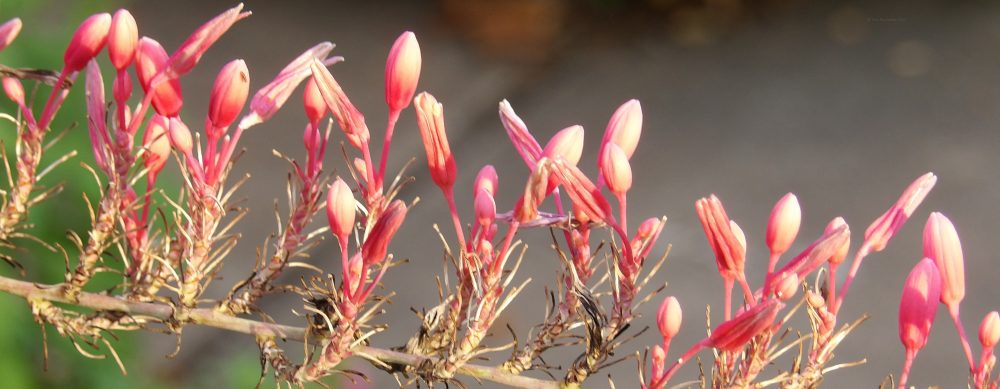
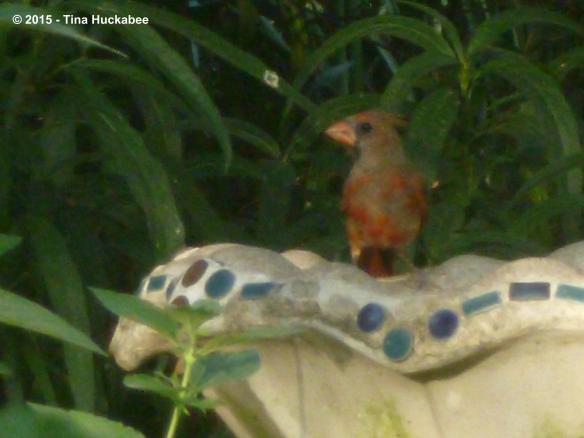
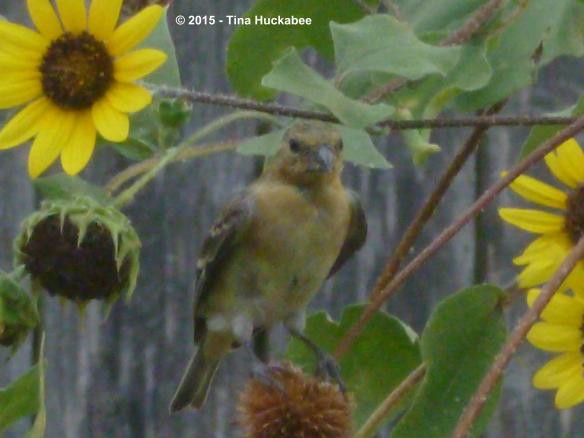




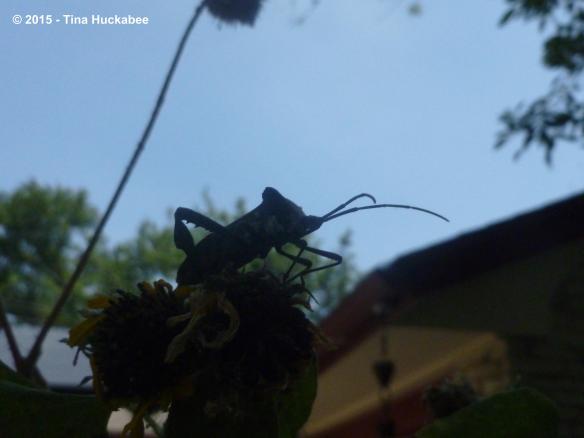



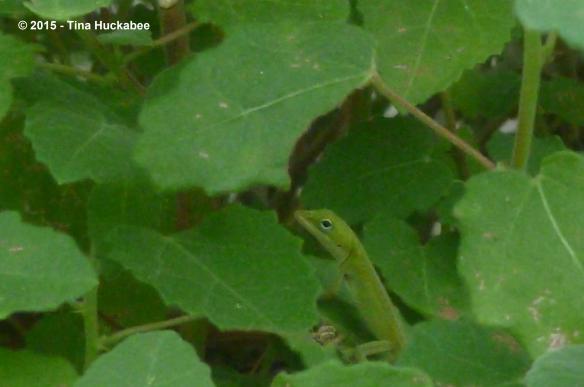





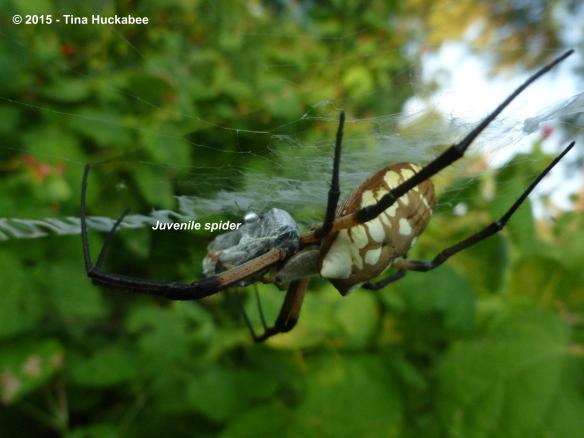
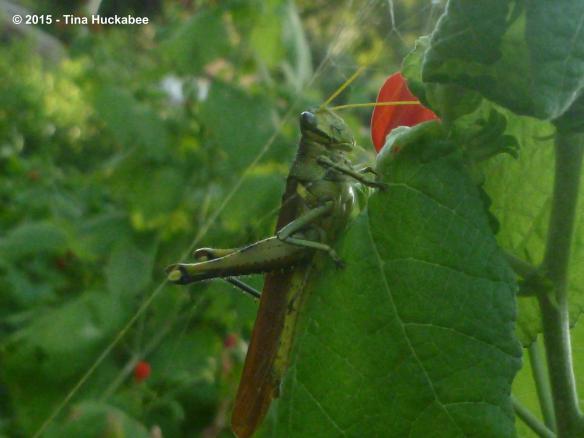
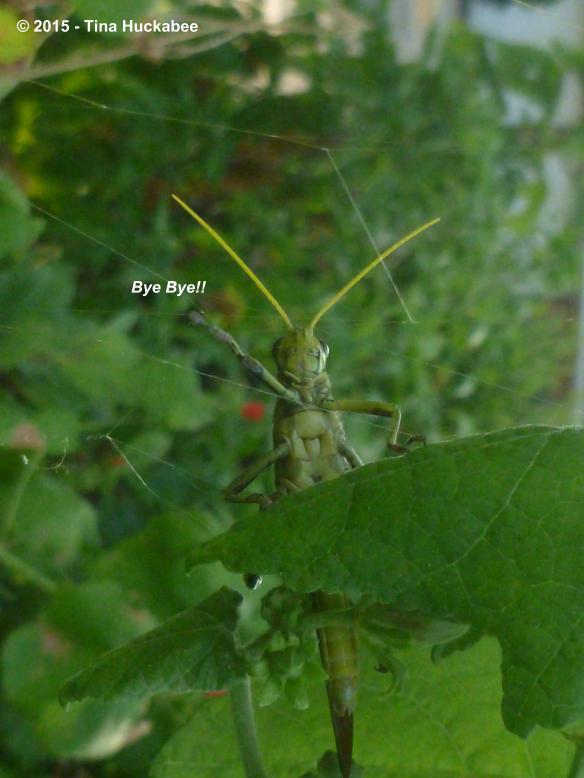
You have had a lot of visitors this month! I’ve seen lots of dragon flies this year and I don’t have any water nearby.
LikeLike
Interesting that you have so many dragonflies, yet no water! They must be hardy Italian dragons. 🙂
LikeLiked by 1 person
Pingback: Wildlife Wednesday: September 2015 | Under the Pecan Leaves
Fun post! I love the superhero pose. What a great angle! And I laughed at the bye bye photo. I do violate the prime directive from time to time. Mostly I release fireflies trapped in webs. My rationale is that I can’t stand seeing the desperate SOS blinks. And I don’t know if it is true but I think that fireflies might be toxic anyway. Unfortunately, I am not nearly dexterous enough to free them without considerable damage to the web.
LikeLike
I just couldn’t bear that the bee had just been caught, was still alive and struggling. I don’t do that sort of thing often, but one can always rationalize an action and I think I did so quite admirably. I damaged the web, but one of the things I read about the black and yellow spiders is that they often have damaged webs and don’t necessarily repair them–I think they just repair the center area where they hang out. And eat my bees.
LikeLike
You still got a lot of good shots with your point and shoot. Wildlife is hard to capture.
LikeLike
Thanks–it takes good close-ups, it’s the distance shots (ahem, bird shots) that don’t quite work out. I didn’t even attempt any photos of hummingbirds.
LikeLiked by 1 person
Yes, hummingbirds are difficult. To get a good shot, a black screen needs to be set up and a camera on a tripod and all day to sit and wait. I just follow them around the yard or shoot through my windows.
LikeLike
That’s good advice, except my windows are not the cleanest. 🙂 I need to be better about carving out time to set up the tripod–that’s where I think I can make some improvement in bird photography. A new challenge–onward!
LikeLiked by 1 person
Wonderful post…I have released a bee or two from webs and when they get caught in my milkweed… I will link in my Nature Notes Charlotte’s web post if you don’t mind as it is a fun one I think… http://ramblingwoods.com/2015/08/31/nature-notes-327it-is-quite-possible-that-an-animal-has-spoken-to-me-and-that-i-didnt-catch-the-remark-because-i-wasnt-paying-attention-%E2%80%95-e-b-white-charlottes-w/ ..Michelle
LikeLike
I’m glad I’m not the only one who interferes, but I guess it’s fine because we’re doing something positive, right?? Thanks for linking–that was a great post that you wrote!!
LikeLike
Pingback: Wildlife Wednesday – Summer Pollinators and others | Gardening Jules
Really great post Tina, I followed your link to the Prime Directive too! I would of interfered on behalf of the Carpenter bee as well. I think my eye has gone out of identifying things this month, I am in a constant dither of could it be this or that, so its lovely to read your confident identifications. Considering you have only a point and shoot to use this month you have captured a brilliant selection of your visitors. Your bird bath is very Gaudiesque, I love it! I am again having brain failure on how to copy a link for my post. I hope this works as I am clearly out of practise with this too. https://wordpress.com/read/post/id/48952516/1951
LikeLike
Ha!! I’m hardly confident and as you stated in your post, it can be very difficult to identify insects–there are such a variety and many with just slight differences. Still, I think it’s good for gardeners to have at least a basic working knowledge of those who live in the garden.
As far as the “Star Trek” reference, I don’t know if you folks in the UK ever saw the 1960s TV series or any of its spinoffs, but there have also been a host of movies. In the last one (I think it was the last one) Benedict Cumberbatch (swoon) played a villain. Superbly, of course.
I love it–“Gaudiesque”–I never thought of it that way. And, your link worked beautifully.
LikeLike
Brava! I think this might be my favorite WW post to date. “Best case” camera or no, you’ve caught so much of what is delightful about these creatures with your photos whether or not the macro view is provided. Best of all is your narrative, which had me laughing aloud more than once.
Here’s my post for September which is tardy due to some sort of technical glitchiness that had me getting up and walking away several times. It may not be my best but I am proud to post it, representing two minor victories – one over machinery and the other over impatience. Onward! : )
http://austinagrodolce.blogspot.com/2015/09/august-in-austin-septembers-wildlife.html
LikeLike
It was a fun post to write. I didn’t really take that many photos this past month, so I felt the choices were limited, but I still enjoyed doing it–which is the point. I hope you swore, in addition to walking away–that always works for me. Sometime, just the swearing works and I don’t have to get out of my seat at all.
LikeLiked by 1 person
Tina I think I may have made a rescue too, though I’m not too keen on spiders so skimmed some of the photos, I like your blue dragon fly, and your musings about the teenage bird, I have a few wee offerings for August, with the wet weather we are still having I do not go out much and most creatures are sheltering, thanks for hosting, Frances
LikeLike
Thank you for reading and participation, Frances. I suspect that most of us who garden have rescued something in peril at one time or another–it’s what we do, I suppose. Thanks for your “wee” offerings!
LikeLike
Pingback: Wildlife Wednesday | Country Garden UK
Wow! You have the most amazing wildlifeTina. We have lots of bees. Here’s the link
LikeLike
I’m thrilled you have lots of bees. EVERYONE should have lots of bees. 🙂 We’re just beginning our second bloom cycle here in Central Texas, so I hope there will be even more in the next couple of months.
LikeLike
Hi Tina, what an interesting post and meme. Gillian at countrygarden blog thought this post that shows the Common Blue butterfly in our meadow might be of interest
LikeLike
Hi Kate!! I’m so glad you checked out my post for Wildlife Wednesday and yes, I love your beautiful Common Blue butterflies, though they don’t look very common to me!
LikeLike
I always enjoy your wildlife posts Tina, you have wonderful birds and fascinating insect life. And you weave such interesting stories. Sometimes your creatures are so weird that I think you might be making them up. A leaf- footed bug? Can that be real?
LikeLike
Haha!! Yup–leaf-footed bugs are a whole group of bugs, actually. Silly name, I guess. They’re in the family Coreidae and according to Wikipedia (of course it must be true 🙂 ), there are over 1,900 species in that order of bugs. Sometimes they’re called “squash bugs”, because they like to eat those plants but the “leaf-footed” nickname comes from that expanded area on the leg of the insect that you can easily see in my photos.
LikeLike
Quite a lot of fun you had with the point-and-shoot this month. I also managed a couple of rescues which may or may not have violated the Prime Directive.
http://rockoakdeer.blogspot.com/2015/09/wildlife-wednesday-september-2015.html
LikeLike
That prime directive gets in the way, doesn’t it?? So glad you’re participating and I know you have lots of wild things in your garden.
LikeLike
It seems we have many of the same birds and bugs, which isn’t surprising, I guess. Of course, we don’t have the Anoles here in the north and I miss them from my visits to the south. I don’t remember seeing any Leaf-Footed Bugs–that one is fascinating. Happy Wildlife Wednesday!
LikeLike
We do sort of share birds back and forth, don’t we? I wish you could host anoles in your garden , but I think they’d find your winters a bit chilly.
LikeLike
What a wonderful variety of visitors you have in your garden! I’m glad you rescued the carpenter bee; as much as I like the garden spiders, I would have a hard time watching him devour the bee, too. We have had swarms of dragonflies lately. I’m not sure what type they are, but they appear in the evening especially and swoop down for mosquitoes and other insects. They never seem to land, so photographing them is impossible, but they’re fun to watch.
LikeLike
Thanks, Rose. There’s usually lots of critters around here, of many sorts. It’s a bit of a trick, this deciding that the bee shouldn’t be a meal for the spider, after all, it’s not like Ms. Spider can call out for pizza–she has to catch her own. Still, I’m also glad I rescued the bee. I know the dragonflies you’re referring to–they never seem to land and I always wonder if they tire out….
LikeLike
I’m so sorry I missed the Wildlife Wednesday! I remembered too late in the evening. You have such great pictures again – I like especially the one with ‘mama’ and baby spider! And the Blue dasher is quite dashing! 🙂
LikeLike
Ah, no worries–there’s always next month. Thanks for reading, though!
LikeLike
So much wildlife to share…I do love seeing juvenile and baby birds about as you will see in my post this month….and I do need to look more for the insects and try to identify them. So many to count….especially the dragonflies this summer. I would have rescued the bee too!
http://www.livingfromhappiness.com/wildlife-lesson-whos-your-momma/
LikeLike
Insects are in some ways easier to photograph than birds, but hard to identify, due to their vast numbers and slight differences. Ha ha–the consensus seems to be on my side with the bee rescue!
LikeLike
So much beauty in your garden this past month! As usual I’m still jealous of your Lesser Goldfinches. I think the American Goldfinches begin to migrate in October, so hopefully it won’t be long before they’re back in abundance around here! You had lovely insects and spiders, too! I haven’t done the “save the bug” thing, but I did (I suppose) save a toad twice this week. Somehow it managed to find its way into a pail of rainwater. Don’t ask me how, surely it couldn’t have leapt that high? Maybe it crawled on a nearby stone and made the leap. It was pedaling vigorously both times I discovered it and the second time I just dumped the water out along with it! Wish I’d had my camera with me…. Wonderful and informative post, good camera or not. Here’s my link for this month, better late than never… Thanks so much for hosting!
LikeLike
Thanks, Anna. I’ve also seen toads get into buckets of water and not be able to escape. Usually, I can rescue them, but once or twice, the end wasn’t so great. I’m so glad you joined in–your posts are always a treat.
LikeLike
Don’t think I could ever tire of seeing your pictures of the green anoles! Looks like your insects are superheroes all round.
LikeLike
Superheroes indeed–working hard to pollinate and provide diversity in the wild-go wildlife!!
LikeLiked by 1 person
Pingback: Wildlife Wednesday, October 2015 | My Gardener Says…